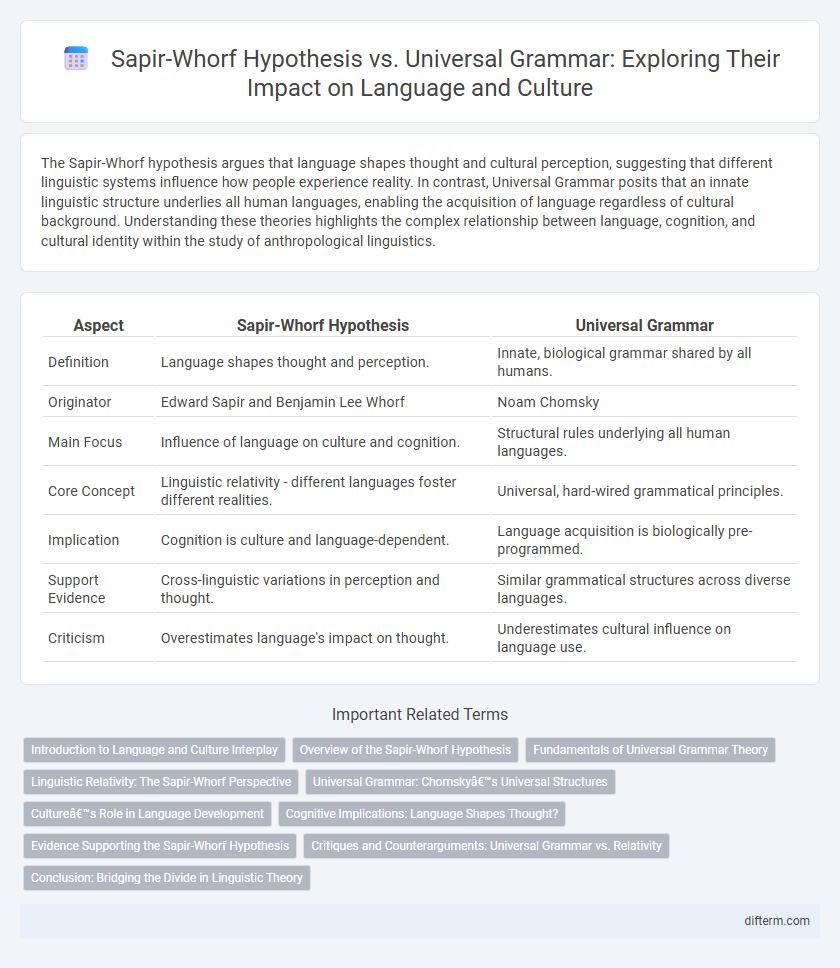The Sapir-Whorf hypothesis argues that language shapes thought and cultural perception, suggesting that different linguistic systems influence how people experience reality. In contrast, Universal Grammar posits that an innate linguistic structure underlies all human languages, enabling the acquisition of language regardless of cultural background. Understanding these theories highlights the complex relationship between language, cognition, and cultural identity within the study of anthropological linguistics.
Table of Comparison
| Aspect | Sapir-Whorf Hypothesis | Universal Grammar |
|---|---|---|
| Definition | Language shapes thought and perception. | Innate, biological grammar shared by all humans. |
| Originator | Edward Sapir and Benjamin Lee Whorf | Noam Chomsky |
| Main Focus | Influence of language on culture and cognition. | Structural rules underlying all human languages. |
| Core Concept | Linguistic relativity - different languages foster different realities. | Universal, hard-wired grammatical principles. |
| Implication | Cognition is culture and language-dependent. | Language acquisition is biologically pre-programmed. |
| Support Evidence | Cross-linguistic variations in perception and thought. | Similar grammatical structures across diverse languages. |
| Criticism | Overestimates language's impact on thought. | Underestimates cultural influence on language use. |
Introduction to Language and Culture Interplay
The Sapir-Whorf hypothesis posits that language shapes cultural perception, suggesting linguistic relativity influences cognition and worldview. In contrast, Universal Grammar, proposed by Noam Chomsky, argues that underlying syntactic structures are innate and shared across all human languages, emphasizing biological constraints over cultural variation. Understanding the interplay between language and culture requires analyzing how linguistic frameworks both reflect and shape social identity, communication patterns, and cultural norms.
Overview of the Sapir-Whorf Hypothesis
The Sapir-Whorf Hypothesis posits that language shapes thought and influences cognitive categories, suggesting that speakers of different languages perceive and interpret the world uniquely. This theory contrasts with Universal Grammar, which argues that all humans share an innate grammatical structure regardless of linguistic differences. Research on the Sapir-Whorf Hypothesis emphasizes the impact of linguistic relativity on cultural worldview and cognitive patterns.
Fundamentals of Universal Grammar Theory
Universal Grammar theory, formulated by Noam Chomsky, posits that the ability to acquire language is innate, with a set of structural rules common to all human languages embedded in the brain. This contrasts with the Sapir-Whorf hypothesis, which suggests language shapes thought and perception based on cultural and linguistic differences. The fundamentals of Universal Grammar emphasize a biological predisposition for language acquisition, independent of specific language environments, highlighting universal syntactic principles underlying diverse languages.
Linguistic Relativity: The Sapir-Whorf Perspective
The Sapir-Whorf hypothesis argues that language shapes thought and cultural perception, emphasizing linguistic relativity by suggesting that speakers of different languages experience reality uniquely. In contrast, Universal Grammar posits innate, biologically determined structures underlying all human languages, independent of cultural differences. Linguistic relativity highlights how vocabulary and syntax influence cognition, affecting memory, categorization, and worldview across diverse cultures.
Universal Grammar: Chomsky’s Universal Structures
Noam Chomsky's Universal Grammar posits that humans possess an innate, biological capacity for language acquisition, characterized by a set of universal structural principles shared across all languages. This framework contrasts with the Sapir-Whorf hypothesis, which argues that language shapes thought and cultural perception, emphasizing linguistic relativity rather than innate structure. Universal Grammar highlights the underlying cognitive architecture enabling rapid language learning and cross-linguistic similarities, supporting the idea of common mental foundations in human culture.
Culture’s Role in Language Development
The Sapir-Whorf hypothesis emphasizes how cultural context shapes linguistic structures, suggesting that language reflects and reinforces cultural perceptions. Universal Grammar posits innate, biological foundations for language common across all humans, minimizing cultural influence. Cultural variation influences vocabulary, idioms, and pragmatics, demonstrating how cultural experiences impact language use within the constraints of innate grammatical principles.
Cognitive Implications: Language Shapes Thought?
The Sapir-Whorf hypothesis posits that language profoundly shapes cognitive processes, suggesting that linguistic structures influence perception and categorization of reality. In contrast, Universal Grammar argues for innate linguistic principles shared across humans, implying cognitive frameworks exist independently of specific languages. These theories highlight differing views on whether cognition is molded primarily by language learning or by universal mental faculties guiding language acquisition.
Evidence Supporting the Sapir-Whorf Hypothesis
The Sapir-Whorf hypothesis finds support in cross-linguistic studies showing that language shapes perception and cognition, such as how color terminology influences color discrimination and memory. Experimental evidence from bilingual speakers reveals that shifting languages can alter thought patterns and decision-making processes, highlighting language's role in shaping experience. Neuroscientific research demonstrates that different linguistic structures activate distinct brain regions, reinforcing the idea that language influences cognitive processes.
Critiques and Counterarguments: Universal Grammar vs. Relativity
Critiques of the Sapir-Whorf hypothesis emphasize its lack of empirical evidence, arguing that linguistic relativity overstates how language shapes thought, whereas Universal Grammar boasts strong cross-linguistic support demonstrating innate syntactic structures shared among all humans. Counterarguments highlight that Universal Grammar provides a biological basis for language acquisition, while proponents of linguistic relativity underscore cultural diversity influencing cognitive patterns differently across languages. The ongoing debate reflects the tension between viewing language as a culturally relative construct versus an inherent, universal mental faculty.
Conclusion: Bridging the Divide in Linguistic Theory
The Sapir-Whorf hypothesis emphasizes language's role in shaping cultural perception while Universal Grammar highlights innate syntactic structures shared across all languages. Recent research suggests these frameworks complement one another, with universal grammatical principles providing a scaffold for culturally specific linguistic expressions. Bridging the divide enhances understanding of how language both reflects innate brain mechanisms and adapts to diverse cultural contexts.
Sapir-Whorf hypothesis vs Universal grammar Infographic

 difterm.com
difterm.com